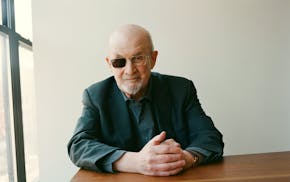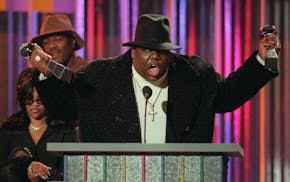Light a firecracker, and the fuse ignites with a burst of sparks. 1963 was like that.
Month after month, all sorts of people lit fuses: black citizens, suburban women, even folk singers.
1963 changed our lives in consequential ways: Minorities marched on Washington, Betty Friedan asked "Is this all?" and Beatlemania began. Yet however these events altered the world, their embers still stubbornly smolder. Young black men are urged to mind their surroundings. Career women are exhorted to "lean in." And we'll always have the Beatles.
But no one knew that in 1963. They only heard a low sizzle growing louder.
"It's crazy how much was going on," said Sara Evans, a University of Minnesota professor who remembers sitting with college classmates to watch the funeral for President John F. Kennedy on her dorm's single TV.
Today and for the next two Sundays, we look back at 1963 as the year when the fuses of change began to spark.
•••
What many people don't know about the March on Washington, which grabbed the nation's attention 50 years ago this week, is that the Rev. Martin Luther King Jr.'s "I Have a Dream" speech almost never happened.
They don't know that he was the last speaker, there not to bring the event to a rousing climax, but to an orderly close.
They may not realize that the crowd of more than 200,000 — twice the number expected — marching in their Sunday best with businesslike deliberation proved a transitional moment in the civil rights movement: a shift from seeking freedom at the lunch counter to demanding economic standing in the marketplace. (The event was officially called the March on Washington for Jobs and Freedom.)
Barely eight months before the massive march, Gov. George Wallace had taken the oath of office on the steps of the Alabama State Capitol, declaring "segregation now, segregation tomorrow, segregation forever." In June, prominent black leader Medgar Evers was shot and killed in his Mississippi driveway. An all-white jury proved deadlocked over his alleged assassin's guilt.
Hundreds of miles to the north in Minnesota, the black community struggled to re-establish itself as bulldozers rumbled away, building Interstate 94 through what had been the Rondo neighborhood. The racially integrated corridor between St. Paul and Minneapolis had been considered a nurturing place in which to raise a family. But the throes of relocation exposed a latent racism. Black families faced discrimination when looking for new houses, spurring the St. Paul National Association for the Advancement of Colored People (NAACP) to organize hearings and protests.
Everywhere, the cultural landscape was shifting. What would be called the generation gap was opening in the areas of music, fashion, politics — and in civil rights, as the March on Washington began to reveal.
"It's always made more sense to talk about this as a transgenerational freedom struggle," said John S. Wright, a professor of English and African-American and African Studies at the University of Minnesota. King's dream about racial harmony would become one of the most famous speeches of the 20th century. However, "the next five years of his life, up until his assassination, basically involved a descent into turmoil and contention within the African-American community," Wright said.
King became more radical as younger activists (who would later become the Black Panthers) challenged the principles of nonviolent action "because of a sense that it had accomplished little beyond desegregating lunch counters," Wright said.
The 1963 March on Washington was not the first one planned. In 1943, black leaders A. Philip Randolph and Bayard Rustin organized a march to pressure the U.S. government to desegregate the armed forces and defense industries, and equalize hiring in defense industries. The march was a week away when President Franklin Roosevelt agreed to those demands and the march was canceled.
Twenty years later, Randolph again organized a march. In 1963, he was in many ways more radical than the younger leaders, Wright said. His belief that the real battles were specific and economic — fair hiring practices, decent housing, better schools, a higher minimum wage — was widely perceived as more challenging, perhaps more threatening, than King's dream about people being judged not by their skin color, but by their character.
This time, the president, John F. Kennedy, a shrewd supporter of civil rights, let the marchers march.
Absent from the podium
Another battle was going on behind the scenes, providing tinder for a different fuse: the struggle for women's rights.
From one perspective, women and blacks had common goals.
"You can find deep roots back in the '50s — a growing prosperity, a growing middle class," said Evans, the history professor. "There were rising aspirations in the black community, rising aspirations of women, with both of those being groups that quickly bumped up against barriers both legal and informal."
By 1963, those rising expectations had reached a point where the ongoing discrimination no longer was tolerable.
"There's the collision of the old status quo and an old hierarchy that's crumbling with newly emerging, self-aware groups that are challenging it," Evans said. "Of course, the backlash is huge."
Black women had been pivotal to the civil rights movement on the local level, Wright said, deeply involved in planning the March on Washington. But it became clear that few women would be heard from that day.
One of them was gospel singer Mahalia Jackson — but she played an important role.
As Clarence Jones, a lawyer who helped draft King's speech, relates in a PBS documentary, "The March" (airing 9 p.m. Tuesday, TPT, Ch. 2), King had been delivering his prepared remarks when Jackson, who had sung earlier, shouted to him.
"Mahalia Jackson, who was sitting on the platform, said, 'Tell them about the dream, Martin. Tell them about the dream,' " Jones said, surmising that she must have heard King talk about this at other times. "I was standing about 50 feet behind him to the left and to the rear. And I watched him — this is all happening in real time — just take the text of this speech and move it to the left side of the lectern, grab the lectern, and look out. And I said to somebody standing next to me, I said, 'These people don't know it, but they're about ready to go to church.' "
Still, the absence of women's voices provoked some of the women leaders, notably Dorothy Cotton and Dorothy Height, to meet after the march to discuss the sexism among those fighting racism. The women ultimately formed their own national organization, which became one of the foundations of the emerging feminist movement.
This did not, however, mean that they were in sync with white women who were absorbing a new book, Betty Friedan's "The Feminine Mystique."
Elaine Tyler May, a historian in American Studies at the University of Minnesota, has written extensively on the 1960s. "Black women were actually put off by Betty Friedan's message," May said, explaining that some black men were becoming prosperous enough that their wives no longer needed to work for white families to support their households. "They finally could stay home and raise their own children instead of some white person's children, and here's Betty Friedan telling them to give up the trap of being a housewife."
Setting the stage for change
The fuses of 1963 went beyond the United States. African countries were gaining independence from British colonialism, which led to fresh images beamed onto American television screens, Evans said. "For Americans under segregation, to look at TV and see heads of state from African nations going to the U.N. was very powerful."
Such political transitions also pressed the U.S. government to support civil rights, May said, even as some state governments resisted. "The national government had to support civil rights — had to — because it was a huge embarrassment when dignitaries from Africa would come and couldn't be served in some restaurants."
Many of these emerging leaders had been educated in the United States, Wright said, so they had experienced segregation as students. "They had very strong personal, as well as political, ties to the enterprise."
The Washington march also was televised, a perspective not lost on organizers who worked long and hard to quell any plans for acts of civil disobedience, much less more aggressive actions. The marchers were, in fact, notable for dressing in their Sunday best, and for the enterprise taking on the pace of a religious procession.
Jack Wilson, who covered the march for the Minneapolis Tribune, wrote: "The single most impressive fact about the demonstration, aside from the size of the crowd, was the businesslike attitude of everyone involved."
Eighteen days later, members of a Ku Klux Klan group hid a box of dynamite under the basement steps of a church in Birmingham, Ala. It exploded as children were assembling for the day's sermon. Four young black girls, three 14-year-olds and one 11-year-old, were killed.
Martin Luther King Jr.'s profile soared in the wake of the march, as the events of 1963 led to more protests, more fire hoses, more police dogs, more violence. Forces were coming together as they never had before. Words that King once had spoken seemed prescient.
"Do your work so well that no one could do it better," he had told a gathering. "Do it so well that all the hosts of Heaven and Earth will have to say, 'Here lived a man who did his job as if God Almighty called him at this particular time in history to do it.' "
Kim Ode • 612-673-7185

Salman Rushdie's 'Knife' is unflinching about his brutal stabbing and uncanny in its vital spirit

